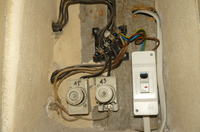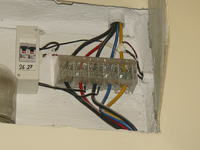It is not a problem to make a perfect product. But in whose interest is it?
Minimalism is a conscious choice. And the future cannot be predicted anyway.
Minimalism is a conscious choice. And the future cannot be predicted anyway.
Czy wolisz polską wersję strony elektroda?
Nie, dziękuję Przekieruj mnie tamŁukasz-O wrote:from the staircase to the blind apartment 5x6mm2 is enough.
Łukasz-O wrote:
We are not talking about a detached house, but about a small apartment in a tenement house, where heating comes from a local boiler room or from the city.
PriweR wrote:Most I see that it writes and 10mm2
PriweR wrote:The question is also whether I can replace the strips at the meter myself because from what I saw they are so small that I will not stick 10mm2 there?
Krzysztof Reszka wrote:Li only to comply with the letter of the law
Krzysztof Reszka wrote:And considering that we will try to replace this installation (WLZ), this 6 mm2 is sufficient.
opornik7 wrote:
You are right that in the future it will be enough for the TN-S 5x6. And what about the so-called in the meantime?
It's easy to advise when you don't subscribe to something.
Krzysztof Reszka wrote:
Li only to comply with the letter of the law.
The information that a colleague is a co-owner adds a lot because a colleague may have an influence on replacing the power supply in the entire tenement house. And considering that you will strive as owners to replace this installation (WLZ), this 6 mm2 is enough.
opornik7 wrote:What strips are you writing about?
zbich70 wrote:What "strips at the counter" do you mean?
Łukasz-O wrote:After all, the author in the first post writes about new protections and RCDs in the housing switchboard. It follows that the receiving installation will be new with separated N and PE.
PriweR wrote:After opening the meter box and after unscrewing the plate that covers the fuse at the meter, strips appeared to me
PE screwed to the housing and not used, then N (in this case PEN) connected and then to the flat and the L1 strip connected, then to the fuse and then to the flat.
Łukasz-O wrote:After all, the author in the first post writes about new protections and RCDs in the housing switchboard. It follows that the receiving installation will be new with separated N and PE.
opornik7 wrote:Mercy!! Take a photo and zapodaj because I don't know what you're writing about.
PriweR wrote:Now I got lost, pack this 10mm2 as you wrote earlier and as the standards say, do you need to use 6mm2
PriweR wrote:In the future, we will probably carry out such a modernization of the network
PriweR wrote:
My point is that I will have to plug the 10mm2 cable into the N strip (now PEN) with so small holes that I will not fit this cable. The L1 wire should be connected to the b20 fuses.


opornik7 wrote:In the apartment. What about the staircase and further to the TG?
zbich70 wrote:PriweR wrote:After opening the meter box and after unscrewing the plate that covers the fuse at the meter, strips appeared to me
What is a "meter box"?
Buddy, no offense, you take an electrician and write like a baker or a bricklayer.
Łukasz-O wrote:Probably four-wire from RG to RP WLZ. What is the problem of separating on a multi-story rosette into N and PE?
PriweR wrote:from the meter to the fuse at the meter I have thin wires, max 4mm2 (although I do not know if it is not 2.5mm2)
opornik7 wrote:
Of course not a problem as long as it is 10 Cu or 16 Al.
